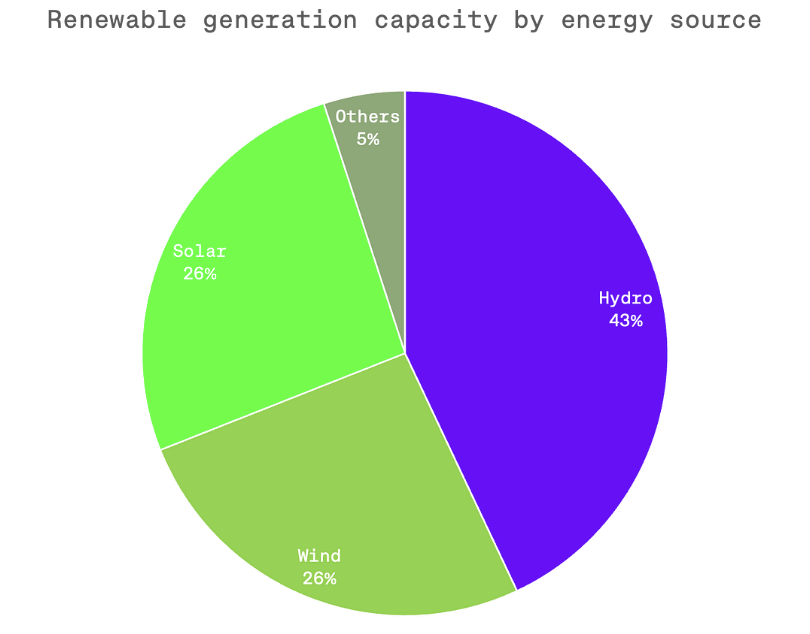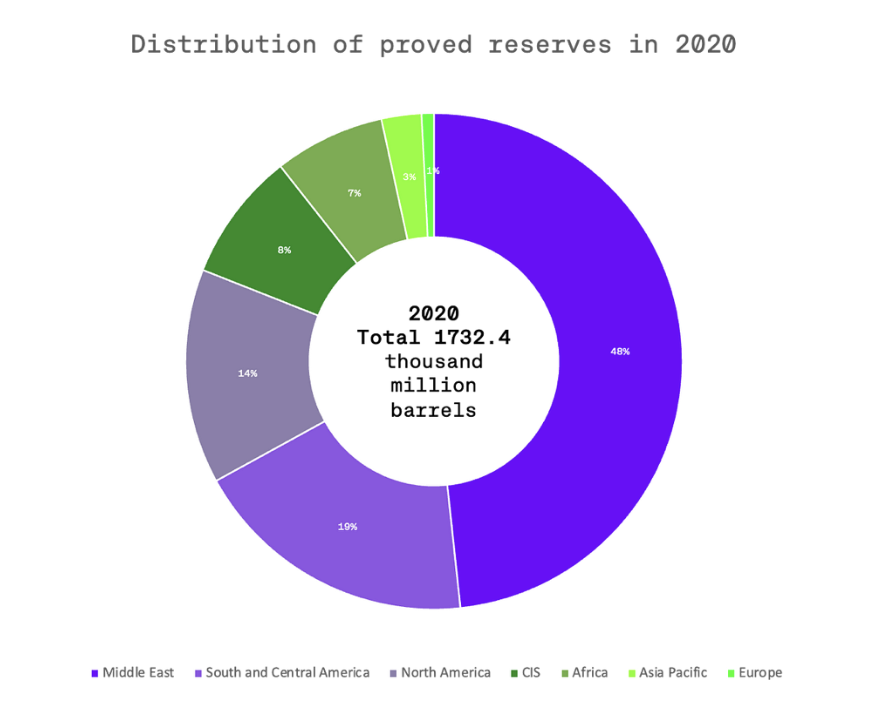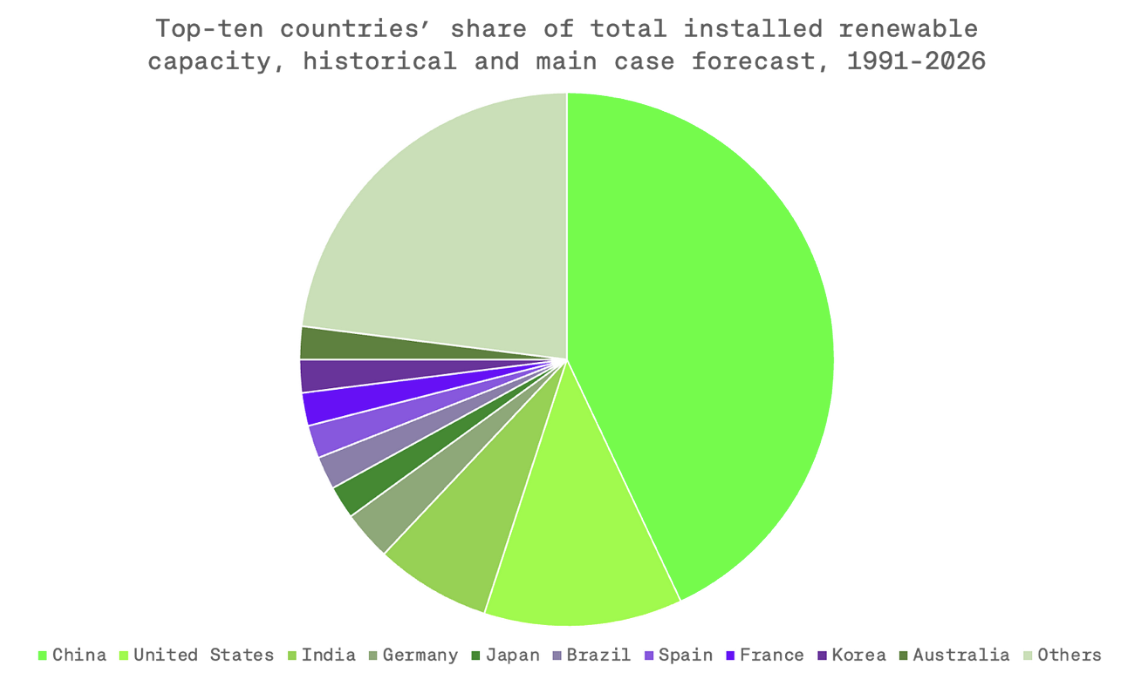Prospects for the development of renewable energy on the scale of states and the planet


· 14 min read
For more than two decades, processes have been going on in the world that can be generally called “energy transition”.
Starting with local events in the developed countries of the West to stimulate renewable energy sources in order to “import substitution”, improve the environment, increase “sustainability of development” and create new industries, they have become global in nature under the banner of combating climate change.
In 2015, some 200 countries participated in the Twenty-First Conference of the Parties to the United Nations Framework Convention on Climate Change (UNFCCC) 2015 and signed the Paris Agreement to limit “global average temperature increases to well below 2°C above pre-industrial levels and continue efforts to limit temperature rise to 1.5°C.”
However, even before the adoption of the Agreement, it was obvious to experts immersed in the topic that the processes of the fundamental transformation of the energy sector had gone far and acquired the character of a “natural evolution” of technologies.
Today, ecology and climate have become objective technological factors. This means that no actor can influence the spread of technologies in the world that contribute to the decarbonization of economic activity. Yes, the transformation was launched artificially with the help of a set of relevant political decisions, but today it is already impossible to roll back. The process has gone too far.
Any organized and regulated major economic activity in the modern world inevitably involves the inclusion of environmental and climate sustainability criteria.
The 26th United Nations Climate Change Conference, held in Glasgow in November 2021, further consolidated the vector of change. On the eve of the event and during its holding, many states that previously did not undertake obligations to achieve carbon (climate) neutrality, have now made these obligations public. As a result of the conference, it turned out that almost all countries of the world are committed to achieving carbon neutrality either by 2050 (EU, UK, Australia, USA, Japan, South Korea), or by 2060 (Indonesia, Kazakhstan, China, Russia, Saudi Arabia), or by 2070 (India).
New government targets to reduce emissions inevitably entail the formation of new technological standards for various sectors of the economy, primarily energy, and make the accelerated and large-scale development of renewable energy sources (RES) inevitable.
According to the International Renewable Energy Agency (IRENA), the share of RES in the growth of generating capacity in the world in 2020 was 82% (in 2019 — more than 70%).

RES, as you know, includes the energy of the sun, wind, water, subsoil, and biological resources. If you look at the indicators of the development of the electric power industry, the largest producer of RES electricity today is hydropower. It accounts for 16% of all electricity produced in the world. At the same time, the fastest-growing (and by a wide margin) sectors of the global power industry, not only the renewable energy sector, are solar photovoltaic and wind energy. If we look at the increase in the capacity of the electric power industry in the world in recent years, we will see that, say, only solar power plants are commissioned every year more than coal, gas, and nuclear power plants combined.

Most of the new RES capacities (91%) in 2020 from the above IRENA statistics are solar and wind power plants. This once again confirms that solar and wind energy are becoming the largest sectors of the global electricity industry.
According to the forecast of the International Energy Agency (IEA), the total share of solar and wind energy in the production of world electricity, which is approximately 10% today, will reach 18% in 2026, and they will bypass hydropower in this indicator.

The undisputed leader, both in terms of installed capacity of solar and wind power plants, and in terms of their generation, is China, which today can rightly be called the largest driver of the energy transition.
According to the National Energy Administration of China (NEA), in 2021, wind power plants (WPPs) with a total capacity of 47.57 gigawatts (GW) were commissioned in the country. This is the second result in the history of China’s wind power industry. The installed capacity of the sector reached 328 GW in 2021.
In the same year, about 53 GW of solar power plants were installed in the PRC, and the installed capacity of the country’s solar energy reached 306 GW.
In total, solar and wind power plants generated 11.7% of electricity in China. According to the benchmarks set by the National Energy Administration, the share of solar and wind in electricity generation should reach 16.5% by 2025.
According to the forecast of the China Electricity Council (CEC), in 2022, 140–150 GW of solar and wind power capacity can be put into operation in the PRC. Incredible numbers!
2021 has been a successful year for the industry. According to the IEA, a record 295 GW of renewable energy capacity has been commissioned worldwide, more than the Agency predicted a year ago. All key global markets saw record or near-record growth rates. For example, in Europe, a record-breaking capacity of solar energy was introduced in history. And in the world as a whole, record numbers were obtained — plus 168 GW, according to SolarPower Europe.
The main direction of development of the energy sector — towards decarbonization and increasing the share of renewable energy — is obvious, however, there remains a high degree of uncertainty about the pace of change on a global scale, even despite the temporary boundaries established by state and international decisions. This uncertainty is primarily explained by the uneven economic development and other peculiarities of different countries, as well as the risks associated with providing energy transformation with resources and their cost.
Since it is impossible to unequivocally plan the world energy development for decades ahead, researchers today, as a rule, use scenario analysis — they consider development options depending on the expected future changes in certain conditions.
It should be noted that in all scenarios, accelerated, outstripping development of solar photovoltaic and wind energy is “predicted”.
For example, the IEA in its flagship annual report with a forecast of global energy development in all four scenarios foresees the rapid growth of solar and wind power, the share of which in the production of electricity in the world in 2050 will reach, depending on the scenario, 40–68%. For comparison, the share of nuclear energy in each of the same four scenarios will be only 8%.
It should not be assumed that the growth of renewable energy is the result of purely political pressure. In a “clean market”, renewable energy sources that do not have fuel costs are more than competitive. However, an accelerated transition to decarbonize global energy certainly requires appropriate policy instruments.
Two factors — environmental/climatic benefits and low cost per kilowatt-hour — contribute to the rapid development of renewable energy, mainly solar and wind energy on Earth. The decrease in their cost is due to the evolution of technology and the implementation of economies of scale.
In December 2021, the Australian Commonwealth Scientific and Industrial Research Organization (CSIRO) and the Australian Energy Market Operator (AEMO) published a draft updated GenCost 2021–2022 study on the economics of different electricity generation technologies in Australia. The report shows that solar and terrestrial wind power facilities are unequivocally cheaper in terms of present value per unit of energy (LCOE) than new facilities of any other generation technologies, even taking into account the additional costs of integrating variable RES into the power grid.
In November 2021, the Lazard investment bank released its regular, already 15th annual Levelized Cost of Energy Analysis (LCOE 15.0) report. Back in 2017, Lazard concluded that wind and solar energy are the cheapest generation technologies. The new report substantiates this conclusion once again.
A study published last year in the scientific journal Proceedings of the National Academy of Sciences (PNAS) shows that solar power is cheaper than coal power in much of China.
In April 2021, Saudi Arabia set a world price record for solar energy. The cost of electricity, which will be generated by the 600 MW Shuaibah photovoltaic plant, will be 1.04 US cents per kWh. It should be emphasized that we are talking about a non-subsidized “single-part” price, set for a long time, and which includes all costs, as well as the income of investors.
Last year, BloombergNEF (BNEF) published data on the global benchmarks (benchmark) of the Levelized cost of electricity (LCOE), for solar photovoltaics (large-scale projects) and onshore wind energy. The authors note that solar and wind power are not only distinguished by the lowest cost per unit of energy among all generation technologies, in some markets the LCOE of solar and wind power plants is lower than the operating costs of coal and gas.

During the past year, as well as at the beginning of the current year, there was an increase in commodity prices and, as a result, prices for components and components for solar and wind power plants increased. This has not yet resulted in an increase in LCOE. However, if this growth continues, renewables could temporarily rise in price for the first time in decades. And this is a factor that can affect the dynamics of the spread of solar and wind generation.
In this matter, much depends on China, which occupies a monopoly position in many sectors of the global “new energy” industry. According to PV InfoLink, China has 86% of the production capacity for the production of polycrystalline silicon, 99% of the production capacity for the production of silicon wafers, more than 80% for the production of photovoltaic cells (cells), 75–80% for the production of solar modules.
In the previous decade, prices for solar-grade polycrystalline silicon (polysilicon), a critical raw material for manufacturing solar panels, have been declining steadily (albeit with small bounces) and in 2020 fell below $6 per kilogram. However, in July there was a sudden shortage of polysilicon. Serious accidents at Chinese factories for the production of this raw material (GCL-Poly / JZS and Daqo companies), as well as the shutdown of a Tongwei plant with a capacity of 20,000 tons in Sichuan province due to flooding, were cited as reasons. In addition, low silicon prices reduced incentives to invest in new production amid huge growth in demand. As a result, prices have crept up and jumped to around $40 per kilogram in 2021, affecting the entire solar energy value chain. From March to the end of 2021, prices for modules and cells increased by 13%, for wafers by 54%, and for solar-grade polysilicon by 177%.
According to the consulting company Rystad Energy, due to rising prices, solar power projects with a total capacity of 50 GW, scheduled for commissioning in 2022 in the world, may be postponed or canceled.
While experts expect polysilicon production capacity to skyrocket (wafer, solar cell, and model capacity are already surplus and growing rapidly) and subsequent price cuts, dependence on one country means increased risks for further solar energy development. Although there is intense competition among manufacturers in the solar industry within China, there is still a clear trend towards concentration, which, in principle, can contribute to the emergence of price-fixing.
This is not to say that other countries are not trying to overcome dependence on China in this strategic, fastest-growing energy industry. India is proclaiming one by one a program to develop its own production chains of the solar industry, starting from the production of polysilicon, Europe is also aiming to build large factories. However, the growth rate of the solar industry in China is so high that it is extremely difficult for other countries to keep up with them and reduce China’s market share.
Another factor that could slow down the development of solar and wind energy is rising interest rates. Since the bulk of the life cycle costs of these RES projects is in the initial capital investment, these projects are more sensitive to the cost of capital than traditional fuel-burning generators.
With the growing share of variable RES (solar and wind energy), the importance of effective solutions for integrating large volumes of unstable generation into energy systems is growing. Such solutions have already been thoroughly developed theoretically and practically, and we are witnessing the introduction of new innovative tools aimed at increasing flexibility and reliability.
Of particular note is the practice of attracting solar and wind power plants to provide services to stabilize the energy system, including providing “synthetic” inertia. It ceases to be exotic and goes into the category of standards. New demand management tools are emerging, for example, involving data centers, which are major energy consumers.
Recent empirical evidence suggests that an increase in the share of solar and wind energy does not lead to a decrease in reliability. For example, today the energy system of Germany, in which the share of solar and wind in the total generation steadily exceeds 30%, is more reliable (SAIDI indicator) than at a time when variable renewable energy sources were not present in the energy system.
In 2021, wind speeds in Europe were, on average, lower than usual, and consequently, wind power generated less electricity than planned. This, in general, not such an incredible event, was added to the global fuel crisis, due to the rapid growth of the global (primarily Asian) economy, which caused an increased demand for raw materials. Electricity producers were forced to buy large volumes of more expensive coal and natural gas, and their additional demand fueled an even greater price spiral.
This once again illustrated the serious challenges associated with the expansion of variable renewable energy sources and the need to increase the flexibility of the energy system, as well as improve market mechanisms. However, the energy crisis will not lead to the curtailment of renewable energy development programs, on the contrary, the upward trend in renewable energy will increase in order to reduce the dependence of the European economy on fossil fuels, the prices of which are so volatile. “The more renewable capacity we can create, the more electricity will come from these sources and the less coal and gas will be needed to generate electricity,” says Christian Rinning-Toennesen, head of Norway’s largest energy company Statkraft.
This is a question we hear quite often.
Yes, they can. In some countries, this task is fixed in the legislation. There are quite a few scientific papers and models that describe the operation of power systems with a 100% share of renewable energy sources.
Moreover, already today there are countries in the world in which renewable energy sources generate almost 100% of electricity. This is, for example, Norway is an oil and gas country in which 95–97% of electricity is generated by hydroelectric power plants, and fossil fuels for electricity generation are (so far) used exclusively to supply energy to the island and remote areas. At the same time, in order to diversify energy sources and for economic reasons, Norway is also actively developing wind energy.
According to the Danish Energy Agency, the share of RES in electricity consumption in Denmark will reach 100% as early as 2027.
The transition to renewable energy is not an end in itself. Countries aim to reduce emissions to achieve carbon neutrality. For example, France and Great Britain are trying to solve this problem, with the help of atomic energy.
The Renewable Energy Act of Germany (EEG) establishes that by 2030 the share of renewable energy sources in electricity consumption should be 65%, and by 2050 all electricity supply should become carbon neutral. This means that some part of the electricity can be imported, and this import will not necessarily come from renewable sources, but, for example, in nuclear power plants, or a (small) part of the electricity can be produced using fossil fuels but using capture technologies and carbon storage (CCS).
The share of renewable energy sources in the production of electricity on Earth is steadily growing.
The climate commitments of countries, the environmental benefits of RES, the large-scale development of the production of components for new energy, and the low cost of energy generated by solar and wind power plants — all suggest that the spread of solar and wind energy has become unstoppable. The accelerated development of RES can be slowed down only as a result of a large-scale force majeure.
Today we see that the Russian invasion of Ukraine can have a multidirectional impact on the development of the world energy sector. On the one hand, Europe rushed to accelerate the already extremely high rates of RES expansion in order to “get rid” of Russian natural gas as soon as possible. The stated targets are extremely ambitious. It is not known whether they will be fully achieved, but they will provide some additional growth, especially since they are supported by China, the largest supplier of relevant technologies and equipment. On the other hand, the destabilization of the economies of many countries can divert forces to solve the pressing problems of survival and lead to political reshuffling. In general, there is a significant factor of uncertainty.
illuminem Voices is a democratic space presenting the thoughts and opinions of leading Sustainability & Energy writers, their opinions do not necessarily represent those of illuminem.
illuminem briefings

Energy Transition · Sustainable Investment
Jonathan Lishawa

AI · Energy Transition
Olaoluwa John Adeleke

Power Grid · Power & Utilities
Mongabay

Energy Transition · Environmental Rights
Forbes

Energy Transition · Energy Management & Efficiency
Forbes

Energy Transition · Energy Management & Efficiency